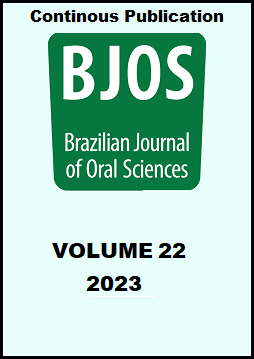Abstract
The aim of this study was to investigate the influence of the quantity and positioning of feldspathic ceramic specimens inside the furnace on their flexural strength and translucency. The tested hypotheses were that the arrangement of specimens in the furnance would not influence 1) the translucency or 2) the biaxial strength of the porcelain. Methods: Ninety porcelain specimens were made (1.2 mm thickness and 13.5 mm diameter) and assigned into two main groups (n=15): G1 group - 15 firing cycles containing only one specimen each, always at the center of the refractory; and G5 group - 15 firing cycles containing five specimen each, where one specimen was at the center of the refractory and four specimens positioned equidistantly on the periphery. The translucency test was performed using a spectrophotometer, followed by the flexural strength test, according to ISO 6872:2015. T-student test was performed for both the mechanical and optical obtained data. Results: The flexural strength of the porcelain was not affected by the positioning (center x periphery) of the specimens inside the furnace (p =0.08), but the translucency was affected (periphery > center; p =0.009). Regarding to the number of feldspathic ceramic specimens, the biaxial flexural strength was affected (p =0.025), as well as the translucency (p <0.05). Conclusion: A higher quantity of feldspathic ceramic specimens for each firing cycle decreased its biaxial flexural strength and translucency. Also, specimens positioned at the center of the refractory became less translucent than those positioned at the periphery.
References
Reitemeier B, Hänsel K, Kastner C, Weber A, Walter MH. A prospective 10-year study of metal ceramic single crowns and fixed dental prosthesis retainers in private practice settings. J Prosthet Dent. 2013 Mar;109(3):149-55. doi: 10.1016/S0022-3913(13)60034-7.
Vichi A, Sedda M, Fonzar FR, Carraba M, Ferrari M. Comparison of Contrast Ratio, Translucency Parameter, and Flexural Strength of Traditional and "Augmented Translucency" Zirconia for CEREC CAD/CAM System. J Esthet Restor Dent. 2016 Mar:28 Suppl 1:S32-9. doi: 10.1111/jerd.12172.
Zarone F, Russo S, Sorrentino R. From porcelain-fused-to-metal to zirconia: Clinical and experimental considerations. Dent Mater. 2011 Jan;27(1):83-96. doi: 10.1016/j.dental.2010.10.024.
Kelly JR. Dental ceramics: current thinking and trends. Dent Clin North Am. 2004 Apr;48(2):viii, 513-30. doi: 10.1016/j.cden.2004.01.003.
Kelly JR. Dental ceramics: what is this stuff anyway? J Am Dent Assoc. 2008 Sep:139 Suppl:4S-7S. doi: 10.14219/jada.archive.2008.0359.
Bajraktarova-Valjakova E, Korunoska-Stevkovska V, Kapusevska B, Gigovski N, Bajraktarova-Misevska C, Grozdanov A. Contemporary dental ceramic materials, a review: chemical composition, physical and mechanical properties, indications for use. Open Access Maced J Med Sci. 2018 Sep 24;6(9):1742-55. doi: 10.3889/oamjms.2018.378.
Tang X, Nakamura T, Usami H, Wakabayashi K, Yatani H. Effects of multiple firings on the mechanical properties and microstructure of veneering ceramics for zirconia frameworks. J Dent. 2012 May;40(5):372-80. doi: 10.1016/j.jdent.2012.01.014.
Yilmaz K, Gonuldas F, Ozturk C. The effect of repeated firings on the color change of dental ceramics using diferente glazing methods. J Adv Prosthodont. 2014 Dec;6(6):427-33. doi: 10.4047/jap.2014.6.6.427.
Bayindir F, Ozbayram O. Effect of number of firings on the color and translucency of ceramic core materials with veneer ceramic of different thicknesses. J Prosthet Dent. 2018 Jan;119(1):152-8. doi: 10.1016/j.prosdent.2017.02.011.
Vanini L. [The color according to Lorenzo Vanini]. Rev Dental Press Estet. 2011;8(4):98-107. Portuguese.
Ozturk O, Uludag B, Usumez A, Sahin V, Celik G. The effect of ceramic thickness and number of firings on the color of two all-ceramic systems. J Prosthet Dent. 2008 Aug;100(2):99-106. doi: 10.1016/S0022-3913(08)60156-0.
International Organization for Standardization. ISO 6872. Dentistry — Ceramic materials. 4th ed. Geneva: ISO; 2015.
Nogueira AD, Della Bona A. The effect of a coupling medium on color and translucency of CAD-CAM ceramics. J Dent. 2013 Aug:41 Suppl 3:e18-23. doi: 10.1016/j.jdent.2013.02.005.
Liu MC, Aquilino SA, Lund PS, Vargas MA, Diaz-Arnold AM, Gratton DG, et al. Human perception of dental porcelain translucency correlated to spectrophotometric measurements. J Prosthodont. 2010 Apr;19(3):187-93. doi: 10.1111/j.1532-849X.2009.00542.x.
Quinn GD. NIST recommended practice guide: fractography of ceramics and glasses. Gaithersburg, MD: National Institute of Standards and Technology; 2016.
Weibull W. A statistical distribution function of wide applicability. J Appl Mech. 1951 Sep;18:293-7.
Deutsches Institut für Normung. DIN ENV 843-5, 2007. Advanced technical ceramics – Monolithic ceramics; mechanical tests at room temperature – Part 5: statistical analysis. DIN; 2007.
Kelly JR, Benetti P. Ceramic materials in dentistry: historical evolution and current practice. Aust Dent J. 2011 Jun:56 Suppl 1:84-96. doi: 10.1111/j.1834-7819.2010.01299.x.
Claus H. The structure and microstructure of dental porcelain in relationship to the firing conditions. Int J Prosthodont. 1989 Jul-Aug;2(4):376-84.
Stawarczyk B, Emslander A, Roos M, Sener B, Noack F, Keul C. Zirconia ceramics, their contrast ratio and grain size depending on sintering parameters. Dent Mater J. 2014;33(5):591-8. doi: 10.4012/dmj.2014-056.
Gonuldas F, Yılmaz K, Ozturk C. The effect of repeated firings on the color change and surface roughness of dental ceramics. J Adv Prosthodont. 2014 Aug;6(4):309-16. doi: 10.4047/jap.2014.6.4.309.
Young HD, Freedman RA. [Young HD, Freedman RA. Física II, Sears e Zemansky: Termodinâmica e ondas]. Rio de Janeiro: Pearson; 2016.
Griffith AA. The phenomena of rupture and flow in solids. Phil Trans Roy Soc Lond. 1921;221:163-98. doi: 10.1098/rsta.1921.0006.
Kelly JR, Cesar PF, Scherrer SS, Della Bona A, van Noort R, Tholey M, et al. ADM guidance-ceramics: fatigue principles and testing. Dent Mater. 2017 Nov;33(11):1192-204. doi: 10.1016/j.dental.2017.09.006.
Aurélio IL, Fraga S, Dorneles LS, Bottino MA, May LG. Extended glaze firing improves flexural strength of a glass ceramic. Dent Mater. 2015 Dec;31(12):e316-24. doi: 10.1016/j.dental.2015.10.012.
Ban S, Okuda Y, Noda M, Tsuruki J, Kawai T, Kono H. Contamination of dental zirconia before final firing: Effects on mechanical properties. Dent Mater J. 2013;32(6):1011-9. doi: 10.4012/dmj.2013-222.
Marchionatti AME, Aurélio IL, May LG. Does veneering technique affect the flexural strength or load-to-failure of bilayer Y-TZP? A systematic review and meta-analysis. J Prosthet Dent. 2018 Jun;119(6):916-24. doi: 10.1016/j.prosdent.2017.11.013.

This work is licensed under a Creative Commons Attribution 4.0 International License.
Copyright (c) 2022 Pablo Soares Machado, Jeanni Gonçalves Camponogara, Camila da Silva Rodrigues, Letícia Borges Jacques, Luiz Felipe Valandro, Marília Pivetta Rippe


